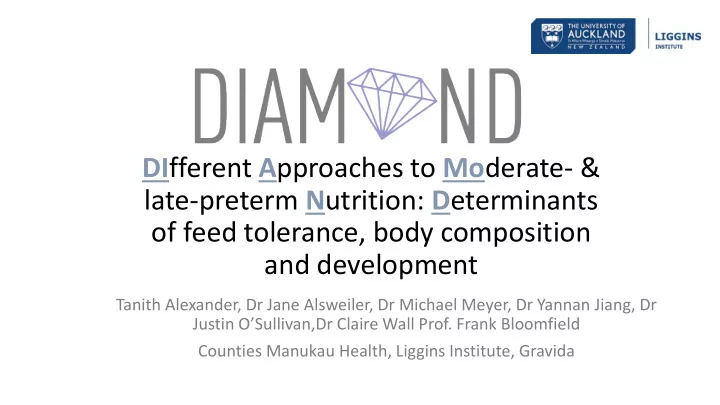

DI fferent A pproaches to Mo derate- & late-preterm N utrition: D eterminants of feed tolerance, body composition and development Tanith Alexander, Dr Jane Alsweiler, Dr Michael Meyer, Dr Yannan Jiang, Dr Justin O’Sullivan,Dr Claire Wall Prof. Frank Bloomfield Counties Manukau Health, Liggins Institute, Gravida
Background • > 80% preterm babies are moderate to late preterm • Delay in establishment of adequate nutrition • Increased fat mass in infancy persisting into childhood • Increased morbidity and mortality in the first 3 years • Increased risk of developmental delay • Increased risk of obesity, hypertension and diabetes in adulthood
Aims Investigate the impact of different feeding strategies currently used in NZ, on feed tolerance, body composition, gut microbial composition and developmental outcome in moderate to late preterm infants
• Trial design: Multi-site, randomised, factorial design, clinical trial • Sites: ADHB and CMH • Participants: Babies 32 +0 – 35 +6 weeks gestation, whose Mothers intend to breastfeed, admitted to NNU, requiring IV insertion
• Exclusion criteria: • Babies in whom a particular mode of nutrition is clinically indicated • Babies with a congenital abnormality
Factorial Design Study • Assess the effect of each intervention separately whilst exploring the effects of their interactions • Evaluate several interventions vs. the control in a single experiment • Efficient and economical • Useful complement to the RCT Collins L, et al. Am Journal of Preventative Medicine. 2014
Dextrose 10% Formula Taste/Smell + + + - - - • 3 independent variable or factors • Babies randomised to receive or not receive each of the three factors • D10% vs Amino acid solution (P100) • Infant formula vs wait for breastmilk • Taste/smell vs standard protocol
Primary Outcomes • Factors i and ii • % fat mass at 4 months corrected age when infant adiposity is predictive of childhood fat mass measured by air displacement plethysmography (APD) using the PEA POD • Factor iii • Time to full enteral feeds
Secondary Outcomes • Length of hospital stay • Days to full suck feeds • Developmental assessment • Breastmilk composition • Gut microbiome composition • Breastfeeding rates at 4 & 6 months
Sample Size • Estimate based on 90% power • Overall type 1 error rate of 5%, alpha per main effect = 0.0167 • 10-15% loss to follow-up Fat mass at 4 months of age • To detect a 3% difference in % fat mass (95% CI) • N = 280 (140 babies in each of the intervention arms: D10% vs P100)
Sample Size Time to full enteral feeds • To decrease time to full enteral feeds from 10 to 7 days (hazard ratio 1.43) • N = 528 (66 babies per condition)
Sample Size • Powered to detect a decrease in the proportion of 2 year olds surviving free from neurodisability from 80% to 70%. • ADHB and CMH each admit > 350 eligible babies per year • Randomisation: Stratified by gestation (32 +0 to 33 +6 , 34 +0 – 35 +6 ), site and sex
Impact and Outcome • Decrease length of stay • Cost saving: $3 million/year per DHB • Decrease rates of obesity in this at risk group • Enable us to develop a package of care • Provide high quality research on which to base clinical practice • Translation into practice, quick and easy to implement nutritional guidelines
Research Team Professor Frank Bloomfield Professor Jane Harding Dr Jane Alsweiler Dr Michael Meyer Dr Yannan Jiang Dr Claire Wall
Recommend
More recommend